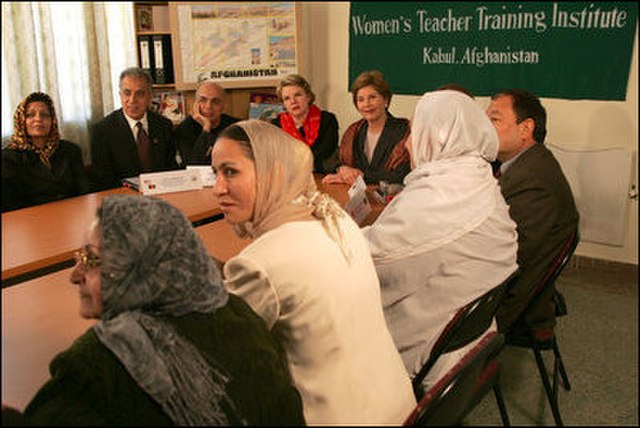By: Iris Sobchak

The future of women in Afghanistan is not necessarily preordained with the Taliban takeover of the country in August. While there is every reason to take Taliban threats towards women seriously, the United States and other world organizations have valuable leverage that can be used to influence the Taliban. When the Taliban seized Kabul in August, President Biden announced that the US would freeze nearly $9.5 billion in assets belonging to the Afghan central bank and would stop shipments of cash to the nation [1]. The Taliban is currently cash strapped and it has been reported that their banking system is teetering on collapse. The United Nations has recommended that this money be released to prevent the collapse of the Afghan economy but there is no reason to believe that the Taliban would use this money to help their people. The United States and world organizations have a good amount of leverage with this money, and they can influence the Taliban by portioning it out slowly. The payments would be made only if the Taliban complies with specific requirements and oversight provided by NGOs and media on the ground. These would include allowing women in the public sphere. Women would not be barred from serving in government, media, businesses, academia, and other economic activities. Wearing the burqa or hijab would not be mandated and public beatings of women by the “morality police’ would end. Afghan women and girls could attend schools and universities. Child marriage under the age of 15 would be banned and women would be allowed to participate in sports.
In order to achieve these ends, the United States needs to create a diplomatic coalition of states and non-government organizations. Many NGOs will rush into Afghanistan or continue to support the country despite the Taliban, but this is a mistake. Continual support provided to Afghanistan under the Taliban only lengthens the suffering of women and children. The United States cannot do it alone and building a coalition will be difficult, but it can be done. It is in the interests of the world that the Taliban does not slide back into old patterns and addressing the rights of women is the first step. It is also in the interests of the Taliban to promote basic rights for women. The Taliban is headed towards another failed state and falling back into civil war, but such a risk can be arrested by committing to women’s rights. If Afghanistan can educate girls and improve women’s access to credit, land, jobs, and training then the Afghan economy can transform and be stabilized more quickly. While it is important to manage expectations about what we can achieve by pressuring the Taliban with funds, this topic is far too important for the world to give up on it.
Helping women around the world has proven remarkable results and Afghanistan is no exception. Societies, where women are educated and contribute to the workforce and economy, are more stable than those countries that do not provide the same opportunities. Improving literacy can have a remarkable effect on women’s earnings. As reported in the 2013/14 Education for All Global Monitoring Report, in Pakistan working women with high levels of literacy skills earned 95% more than women with weak or no literacy skills. The differential was only 33% amongst men [2]. Educated women are empowered to take a greater economic role in their families and communities, and they tend to reinvest most of what they earn back into their families. They also improve the education of their children as literate mothers produce literate and healthier children. According to UNICEF, the power of education on economic growth is significant, as a one percentage point increase in female education raises the average gross domestic product (GDP) by 0.3 percentage points and raises annual GDP growth rates by 0.2 percentage points [3]. The Brookings Institute reported that since 2004 the number of girls attending school increased from 10 to 33 percent and at the same time the life expectancy for women grew from 56 to 66 years [4].
Afghanistan has a long way to go to rebuild and become a stable society, but the process starts with recognizing women and their rights and what they can bring to their country. Oppressing and beating down over 50 percent of a country’s population can only bring one outcome – that of a disordered and unstable nation. Time is running out to help the women of Afghanistan, but we can change the current trajectory of Taliban policies if we make this push for this change now and build a coalition to support it.
[1] Jeff Stein,” Biden administration freezes billions of dollars in Afghan reserves, depriving Taliban of cash.” The Washington Post, 17 August 2021, https://www.washingtonpost.com/us-policy/2021/08/17/treasury-taliban-money-afghanistan/.
[2] “Teaching and Learning: Achieving Quality for All.” UNESCO Education For All World Monitoring Report, 2013/14, http://uis.unesco.org/sites/default/files/documents/teaching-and-learning-achieving-quality-for-all-gmr-2013-2014-en.pdf.
[3] Jo Bourne, “Why Educating Girls Makes Economic Sense.” Global Partnership for Education, 2014, https://www.globalpartnership.org/blog/why-educating-girls-makes-economic-sense.
[4] “Expanding and Improving the quality of Girl’s Education in Afghanistan.” Brookings Institute Blog, https://www.brookings.edu/blog/education-plus-development/2015/08/19/expanding-and-improving-the-quality-of-girls-education-in-afghanistan/.
